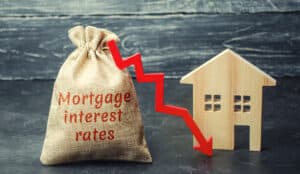When you’re planning to buy a home or refinance, one of the most important questions is: What affects mortgage rates? While the number you see advertised might seem straightforward, the truth is that mortgage rates are influenced by a variety of factors — some global, some personal.
In this article, we’ll break down the economic forces, financial benchmarks, and personal qualifications that shape your mortgage interest rate — so you can better understand how lenders determine your rate and how to secure the best one possible.
1. How Are Mortgage Interest Rates Determined?
Mortgage rates aren’t set arbitrarily. They’re based on a combination of macroeconomic trends, financial markets, and borrower risk.
There are two primary forces at work:
-
Market-based factors (inflation, Federal Reserve policy, bond yields)
-
Borrower-based factors (credit score, loan amount, down payment)
Together, these help lenders calculate the level of risk — and the appropriate rate — for every mortgage.
2. Economic Indicators That Influence Mortgage Rates
Several broad economic forces influence how rates are set day to day:
Inflation
As inflation rises, the purchasing power of money decreases, which prompts investors to demand higher interest returns. Mortgage rates often rise to keep up with inflation trends.
The Federal Reserve
Although the Fed doesn’t directly set mortgage rates, it heavily influences them through its benchmark interest rate and monetary policy. When the Fed raises or lowers the federal funds rate, mortgage rates often follow the same direction.
Bond Market and the 10-Year Treasury Yield
Mortgage rates are closely tied to the 10-year Treasury yield. When investors flock to safer assets like bonds (as they often do during uncertainty), bond prices go up, yields go down, and mortgage rates often follow.
Economic Growth
Strong economic performance can push interest rates higher, as increased demand for credit and concerns over inflation surface. Weak growth or recession fears may lower rates.
Global Events
Geopolitical instability, supply chain disruptions, or international financial crises can all lead to shifts in mortgage rates, often by driving investor behavior in bond markets.
3. Personal Factors That Impact Your Mortgage Rate
Beyond the economy, lenders look at your personal financial profile when setting your mortgage rate.
Credit Score
Higher credit scores generally receive lower interest rates. Borrowers with scores over 740 may qualify for the best rates, while scores under 680 may lead to noticeably higher costs.
Related: The Role of Credit Scores in Mortgage Approval
Down Payment
A larger down payment reduces lender risk. Putting down 20% or more may qualify you for better rates and allow you to avoid PMI (Private Mortgage Insurance).
Loan Amount and Loan-to-Value Ratio (LTV)
Lenders assess how much equity you’ll have in the home. A lower LTV (meaning a higher down payment) generally leads to more favorable terms.
Debt-to-Income Ratio (DTI)
Your monthly debt obligations compared to income affect your approval and your rate. A lower DTI signals better financial stability.
Read more: Understanding DTI
Loan Type and Term
Rates vary depending on whether you choose a fixed-rate mortgage, an ARM (adjustable-rate mortgage), or a government-backed loan like FHA, VA, or USDA.
Explore: Advanced Conventional Mortgage Calculator
4. How Daily Rate Changes Work
Rates don’t stay still for long. They often change daily, even hourly, based on real-time shifts in the bond market and economic news.
Lenders use a blend of:
-
Market conditions
-
Risk-based pricing
-
Internal cost models
That’s why rate quotes from different lenders — or even the same lender on different days — may vary.
5. Fixed Mortgage Rates vs. Adjustable Rates
If you’re considering your loan structure, it’s important to understand how fixed and adjustable rates differ:
Fixed-Rate Mortgages
-
Stable interest rate for the entire term
-
Popular for long-term homeownership
-
Less risk of payment shocks
Adjustable-Rate Mortgages (ARMs)
-
Lower initial rate, but subject to increase after introductory period
-
Best for short-term ownership or when rates are falling
Use our Mortgage Rates Tracker to compare today’s averages.
6. How to Lock In a Lower Mortgage Rate
While you can’t control the economy, you can take proactive steps to secure a lower rate:
-
Improve your credit score
-
Increase your down payment
-
Choose a shorter loan term (like 15 years)
-
Pay discount points at closing
-
Compare lenders and negotiate
-
Use tools like our Loan Affordability Calculator
FAQ: What Affects Mortgage Rates?
What’s the biggest factor that affects mortgage rates?
The most influential factor is inflation. When inflation is high, mortgage rates typically rise to keep up with reduced purchasing power.
Do all lenders offer the same rate?
No. Lenders base rates on market benchmarks but also factor in overhead costs, risk models, and profit margins — so offers can vary.
Can I negotiate my mortgage rate?
Yes, especially if you have strong credit. It’s often possible to negotiate lender fees or pay discount points to reduce your rate.
What’s the relationship between mortgage rates and the Fed?
While the Fed doesn’t set mortgage rates, it controls short-term rates that influence lending behavior. When the Fed raises rates, mortgage rates often follow.
How often do mortgage rates change?
Rates can fluctuate daily. Lenders adjust rates in response to bond market activity, economic data releases, and global events.
Final Thoughts
Understanding what affects mortgage rates gives you a clearer view of both the housing market and your own financial opportunities. While factors like inflation, the Federal Reserve, and bond markets shape national rate trends, your personal credit, debt-to-income ratio, and down payment directly influence the rate a lender offers you.
If you’re preparing to buy a home or refinance, use tools like our Mortgage Rates Tracker and Loan Affordability Calculator to get a clearer picture of where you stand. And don’t forget — improving your credit or shopping multiple lenders can make a real difference in your long-term borrowing costs.
Even in a shifting economic environment, informed borrowers can still secure strong rates and build smart, sustainable homeownership strategies.
Related Posts

Tax Benefits of Rental Property: Advanced Strategies for Real Estate Investors
Rental properties offer some of the most powerful tax benefits available to individual investors — but most landlords only scratch the surface. If

The History of Mortgage Lending in the United States
Mortgage lending has shaped the American dream for generations — but it wasn’t always the standardized, accessible system we know today. From early

How Does Mortgage Interest Work? Understanding Rates, Costs, and Savings
Whether you’re buying your first home or refinancing, mortgage interest can feel like a mystery. You know it adds cost — but how

